East to Kiev . . . Then West to Lviv
Ukraine, August 17-20
We rose early Thursday morning in Gura Humorului, Romania, to begin a drive of more than 600 kilometers to Kiev, Ukraine. The border presented no problems, but we missed a turn in Chernovitsy, the capital of Austrian Bucovina before World War I, and were treated to a city tour on its cobblestone streets. The rest of the trip was unexceptional but tedious as we struggled to pass one truck after another on the two-lane highway, which ran through fields, woods, villages, and a few cities on the Ukrainian steppe. After 10 hours on the road, we were happy to reach the Hotel Rus in Kiev, a late Soviet-era hostelry renovated to the point of acceptability.
Kiev is a beautiful city, built on hills overlooking the Dnepr River. We enjoyed its greenery while walking to the Pecherska Lavra, the city’s famous 20-hectare caves monastery, which is again in operation under the authority of the Russian Orthodox Patriarch in Moscow. Used as burial sites for the monks beginning in the 11th Century, the caves can now be visited by the faithful and the curious, who carry candles into the dark, narrow passages to see the monks’ shrouded, sometimes mummified remains. We toured one section of the caves but found the crush of visitors overwhelming and the candles downright dangerous.

Pecherska Lavra and Dnepr River
The aboveground sights of the Lavra are generally restorations, including the Dormition Cathedral, where rebuilding continues, but we were impressed by the 11th-Century Troitskaya (Trinity Gate) Church, spared in the war, which has a Baroque interior executed at the time Catherine the Great was bringing western European influences to her empire. In this respect Troitskaya is an interesting contrast to the Cathedral of St. Sophia, located in central Kiev, and easily the most impressive architectural monument we saw. There the Westernizers placed a Baroque shell over the exterior but left undisturbed the 11th Century Byzantine interior with its fantastic mosaics and frescoes. Some might call St. Sophia a metaphor for this part of Europe.
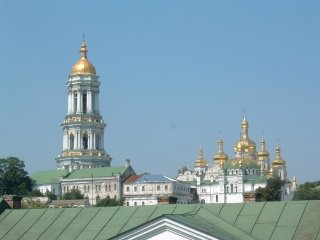
Dormition Cathedral and bell tower, Pecherska Lavra, Kiev

Trinity Gate Church, Pecherska Lavra, Kiev
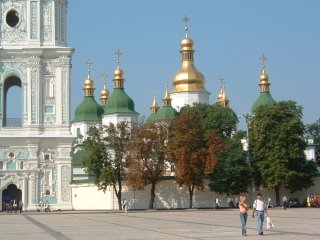
St. Sophia's Cathedral, Kiev
We also visited secular Kiev, including Independence Square, where demonstrators from Pora and other groups were still displaying banners supporting the ideals of the Orange Revolution and warning Putin “to keep your hands off Ukraine.” Seeking some nightlife, we ate at a funky restaurant featuring a trumpet-accordion-keyboard trio that performed everything from modern jazz to Ukrainian folk songs. We were especially appreciative when they played a Glenn Miller tune from “Sun Valley Serenade.”
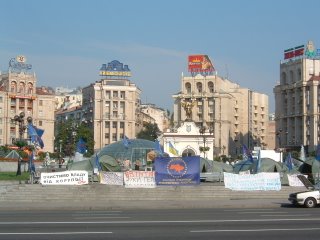
Independence Square, Kiev
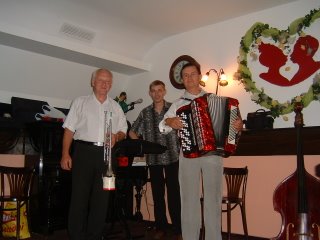
Trio at Chasing Two Hares restaurant, Kiev
On Saturday we headed west to Lviv on another tedious drive that became all the more annoying when the road surface deteriorated. Fortunately, we were delighted by our destination, the modern, immaculately clean Hotel Eney, a small inn that reminded us more of Austria than of the former USSR. The similarity is not surprising, perhaps, for Lviv was the administrative center of Austrian Galicia in Habsburg times as reflected in its Vienna-style opera house and other urban architecture.

Opera House, Lviv
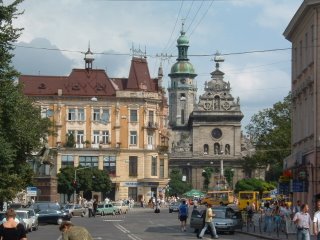
Lviv street scene
Clearly, however, the city’s showpiece is the Market Square, which features buildings from the 15th, 16th, 17th and 18th centuries. The square is now under renovation, and when finished, it will rival the restored pedestrianized areas of Bratislava and Cracow. As we wandered through the downtown area on Sunday morning, we were struck by the number of churches—Roman Catholic, Uniate, Orthodox, and a few Protestant, as befits this cultural crossroads—and the numbers of people listening outside as the services were piped through a PA system.
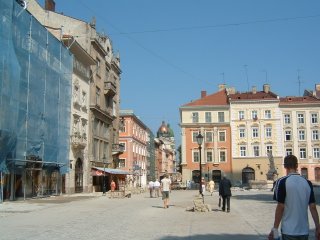
Market Square, Lviv

0 Comments:
Post a Comment
<< Home